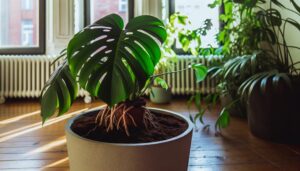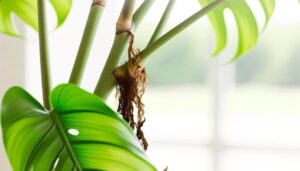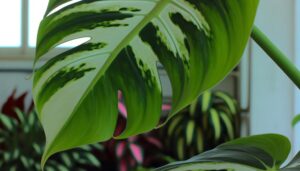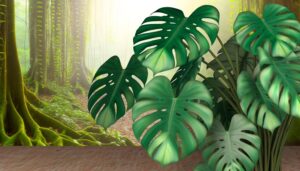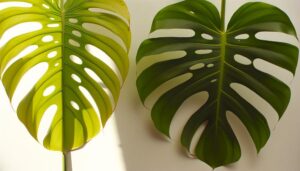Monstera Lechleriana Vs Adansonii: Which One Better!
Comparing Monstera lechleriana and Monstera adansonii, you’ll notice significant differences in leaf size and fenestration. Monstera lechleriana boasts larger, lanceolate leaves up to 60 cm long with fewer, larger holes.
In contrast, Monstera adansonii has smaller, oval leaves, rarely exceeding 30 cm, with an intricate lace-like pattern of numerous small perforations. Monstera lechleriana climbs well with aerial roots and prefers moss poles, while Monstera adansonii thrives in hanging baskets with a trailing habit.
Both love bright, indirect light and periodic fertilization for optimal health. If you keenly observe these details, you’ll distinguish these striking plants effortlessly.
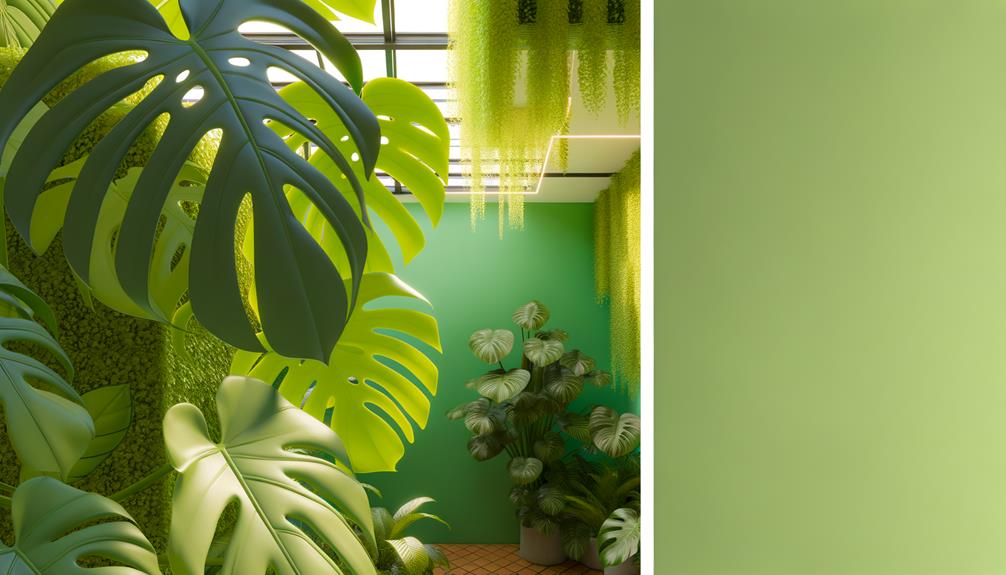
Key Takeaways
- Monstera lechleriana has larger, lanceolate leaves up to 60 cm, while Monstera adansonii has smaller, oval-shaped leaves up to 30 cm.
- Monstera lechleriana features fewer, larger fenestrations, whereas Monstera adansonii has numerous smaller perforations forming a lace-like pattern.
- Monstera lechleriana climbs using aerial roots and thrives on moss poles, while Monstera adansonii has a trailing growth habit suitable for hanging baskets.
- Both species prefer bright, indirect light; direct sunlight can damage leaves, and insufficient light leads to leggy growth.
- Propagation of both species is best done through stem cuttings, with Monstera lechleriana benefiting from larger support structures.
Monstera Lechleriana vs. Adansonii: Key Differences in Size, Care, and Growth
| Aspect | Monstera Lechleriana | Monstera Adansonii |
|---|---|---|
| Leaf Size | Larger, up to 20 inches (50 cm) | Smaller, around 6-12 inches (15-30 cm) |
| Growth Rate | Moderate, can reach up to 6-8 feet (1.8-2.4 m) | Fast, can grow up to 13 feet (4 m) with support |
| Leaf Shape | Less fenestrated, more solid structure | Highly fenestrated with distinct holes |
| Light Needs | Bright, indirect light | Bright, indirect light |
| Watering Frequency | Once every 1-2 weeks, depending on soil moisture | Once every 1-2 weeks, based on humidity |
| Ideal Humidity | 60-80% | 60-90% |
| Temperature Tolerance | 65-85°F (18-29°C) | 65-85°F (18-29°C) |
| Toxicity to Pets | Toxic to cats and dogs | Toxic to cats and dogs |
| Price Range | $50 – $150 | $30 – $100 |
Origins and Background
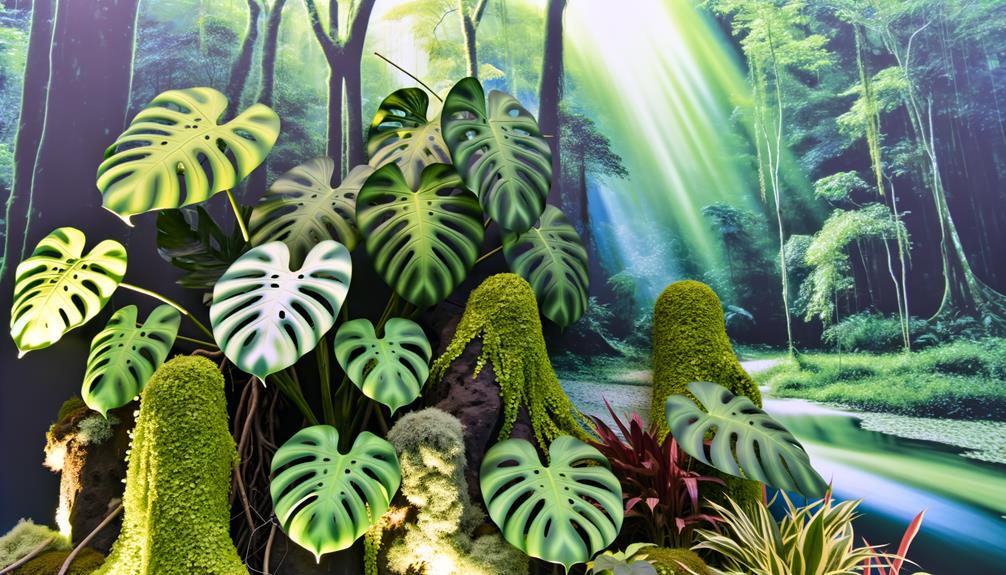
Have you ever wondered where the Monstera lechleriana and Monstera adansonii originate from? These intriguing species hail from the tropical rainforests of Central and South America.
Monstera lechleriana is primarily found in countries like Peru and Ecuador, thriving in humid, shaded environments. On the other hand, Monstera adansonii, also known as the Swiss cheese vine, is native to a broader range, including parts of Mexico down to Panama.
In their natural habitats, both species are epiphytes, growing on trees and absorbing nutrients from the air and rain. Their ability to climb and attach to surfaces allows them to reach sunlight in dense forest canopies.
Understanding their origins helps explain their care needs and growth patterns in cultivation.
Leaf Shape and Size
Monstera lechleriana leaves are typically larger and more elongated than those of Monstera adansonii, which feature smaller, oval-shaped leaves with characteristic fenestrations.
When examining Monstera lechleriana, you’ll notice its leaves can reach impressive lengths, often extending over 60 cm, displaying a lanceolate shape. In contrast, Monstera adansonii’s leaves seldom exceed 30 cm and are more elliptical.
| Feature | Monstera lechleriana | Monstera adansonii |
|---|---|---|
| Leaf Length | Up to 60 cm | Up to 30 cm |
| Leaf Shape | Lanceolate (elongated) | Elliptical (oval) |
| Leaf Width | 10-15 cm | 5-10 cm |
Understanding these differences will help you identify and care for each species effectively, ensuring their best growth and health.
Fenestration Patterns
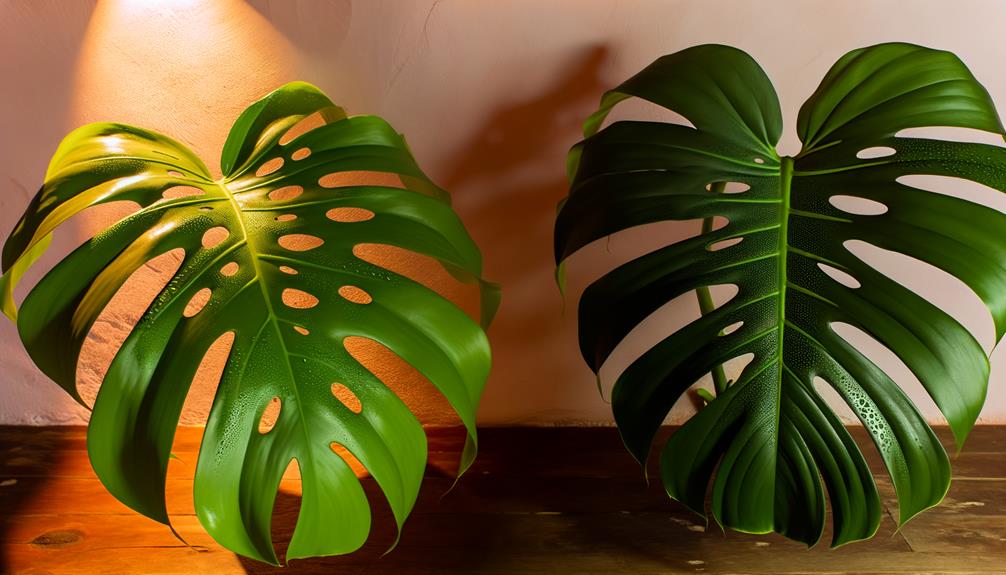
When comparing fenestration patterns, you’ll observe that Monstera lechleriana exhibits fewer, larger holes, whereas Monstera adansonii features numerous smaller perforations throughout its leaves.
The fenestrations in Monstera lechleriana are typically elongated and can span significant portions of the leaf surface, giving it a dramatic appearance. In contrast, Monstera adansonii’s leaf perforations are more evenly distributed and smaller, often forming a lace-like or netted pattern.
These fenestrations serve an evolutionary purpose, reducing wind resistance in their natural rainforest habitat. By examining the leaf structure closely, you can distinguish between the two species based on these unique fenestration patterns.
This characteristic is essential for proper identification and understanding of each plant’s adaptability and aesthetic appeal.
Growth Habit
When comparing the growth habits of Monstera lechleriana and Monstera adansonii, you’ll notice distinct differences.
Monstera lechleriana tends to climb vigorously, using aerial roots to anchor itself, while Monstera adansonii often exhibits a trailing growth pattern.
Additionally, Monstera lechleriana typically develops larger leaves than Monstera adansonii, which contributes to their unique growth forms.
Climbing Versus Trailing
Unlike the trailing growth habit of Monstera adansonii, Monstera lechleriana exhibits a distinct climbing behavior, using aerial roots to anchor itself to vertical supports. This climbing tendency allows Monstera lechleriana to ascend trees and structures in its native habitat, maximizing light capture and growth.
When differentiating between these two species, consider:
- Aerial roots: Monstera lechleriana develops robust aerial roots for climbing, whereas Monstera adansonii’s roots are more suited for trailing.
- Support requirements: M. lechleriana thrives with moss poles or trellises, while M. adansonii prefers hanging baskets or pots.
- Growth direction: The former grows vertically, the latter cascades downwards.
- Light adaptation: Climbing behavior in M. lechleriana aids in accessing higher light levels, unlike the trailing M. adansonii.
Understanding these growth habits helps in providing best care.
Leaf Size Comparison
In comparing leaf size between Monstera lechleriana and Monstera adansonii, you’ll notice that M. lechleriana typically boasts larger, more elongated leaves. The leaves of M. lechleriana can grow up to 60 cm long and are generally more lanceolate, offering a more dramatic and robust appearance.
In contrast, M. adansonii leaves are usually smaller, reaching around 30 cm in length, and have a more ovate shape. M. adansonii is also known for its distinctive fenestrations—oval holes that develop as the plant matures—while M. lechleriana’s fenestrations are less pronounced.
This difference in leaf size and shape influences their growth habits, with M. lechleriana presenting a more vigorous climbing habit compared to the trailing nature of M. adansonii.
Light Requirements
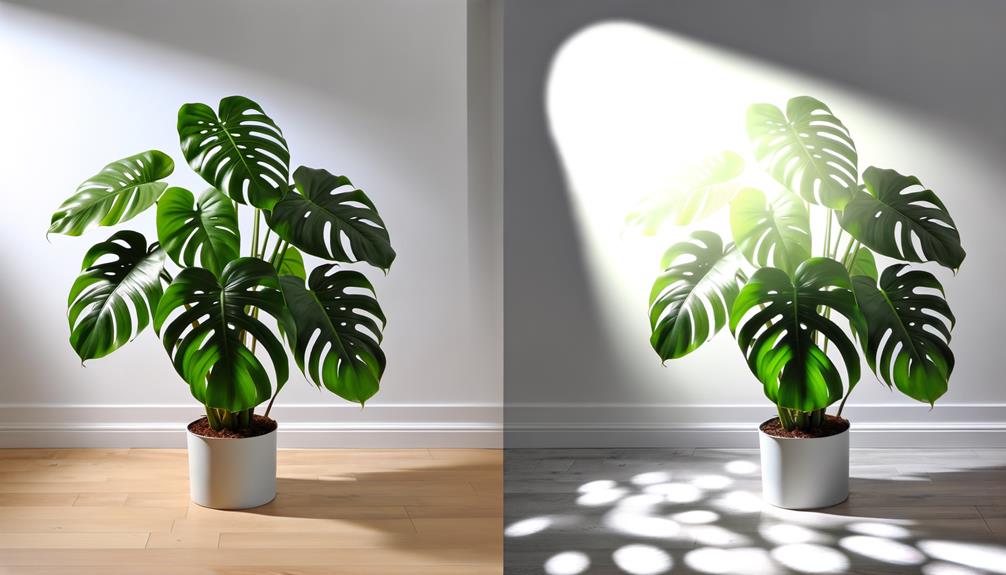
Both Monstera lechleriana and Monstera adansonii thrive in bright, indirect light to mimic their natural understory habitat. Providing the correct lighting conditions promotes ideal growth and health for these species.
Direct sunlight can scorch the leaves, causing damage, while insufficient light can lead to leggy growth and reduced fenestration.
Promote your Monstera receives:
- Filtered sunlight: Use sheer curtains or place the plant near a north or east-facing window.
- Consistent light levels: Avoid drastic changes in light exposure.
- Artificial lighting: Supplement with fluorescent or LED grow lights if natural light is inadequate.
- Rotation: Periodically rotate the plant for even light distribution.
Watering Needs
Maintaining proper watering for Monstera lechleriana and Monstera adansonii is crucial to prevent root rot and support vibrant growth. Both species thrive in consistently moist, but not waterlogged, soil. You should water them when the top inch of the substrate feels dry.
Too much water leads to root rot, while too little causes leaf wilting and browning. Use lukewarm, dechlorinated water to avoid shocking the roots. During winter, reduce watering frequency as the plants’ growth slows.
Monitor the humidity levels; both Monstera species prefer high humidity, around 60-80%. Misting the leaves can help but avoid over-saturation. Implementing a consistent watering schedule guarantees that Monstera lechleriana and Monstera adansonii remain healthy and robust.
Soil Preferences
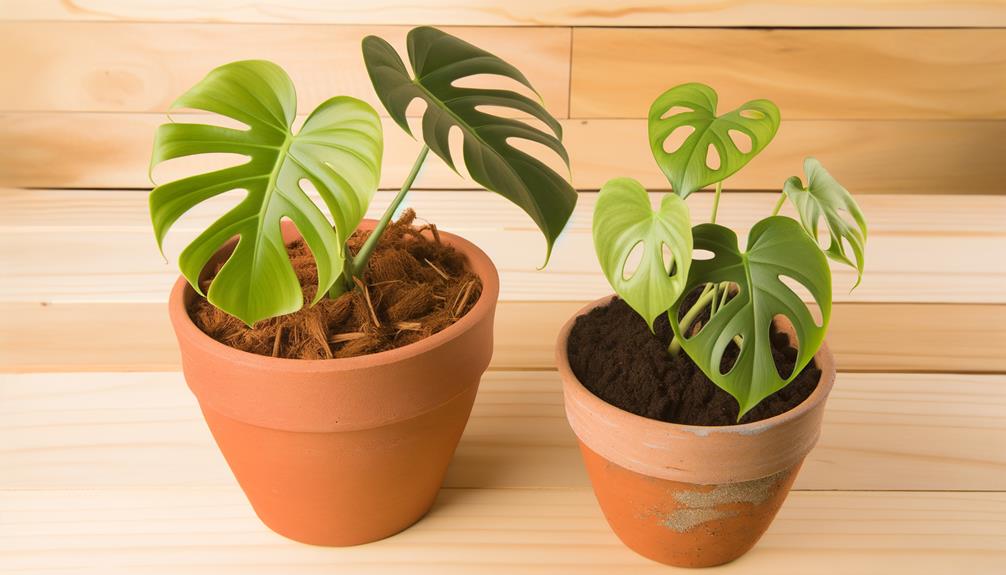
To complement their watering needs, Monstera lechleriana and Monstera adansonii thrive best in a well-draining soil mix rich in organic matter. You’ll want to create a medium that retains moisture without becoming waterlogged.
Key components for an ideal soil mix include:
- Peat moss: Enhances moisture retention while providing aeration.
- Perlite: Improves drainage and prevents soil compaction.
- Pine bark: Adds organic matter and aids in drainage.
- Coconut coir: Maintains moisture levels and promotes root health.
These elements ensure the roots receive sufficient oxygen and nutrients, preventing root rot and other moisture-related issues. By mimicking their natural habitat, you create optimal growing conditions for both Monstera species.
Understanding these preferences will help you maintain healthy, thriving plants.
Fertilization Tips
When fertilizing Monstera lechleriana and Monstera adansonii, use a balanced, water-soluble fertilizer like a 20-20-20 formulation. Apply the fertilizer every 4-6 weeks during the growing season to promote vigorous growth.
Make sure you dilute the fertilizer to half strength to prevent root burn and nutrient overload.
Best Fertilizer Types
Selecting the appropriate fertilizer for your Monstera lechleriana and Monstera adansonii guarantees excellent growth and vibrant foliage. Both species benefit from a balanced, water-soluble fertilizer. Here are some key types:
- Liquid Fertilizer: Provides immediate nutrients, ideal for fast absorption.
- Granular Slow-Release Fertilizer: Offers consistent nutrient supply over time.
- Organic Fertilizer: Enhances soil health and microbial activity, promoting long-term vitality.
- Foliar Fertilizer: Directly applied to leaves for quick nutrient uptake.
Choosing the right type depends on your specific needs and growing conditions. Liquid fertilizers like 20-20-20 (N-P-K) ratios work well for rapid growth phases, while organic options ensure a sustainable nutrient profile. Understanding each type’s benefits helps you make informed decisions for optimal plant health.
Optimal Application Frequency
Determine the best application frequency for fertilizing Monstera lechleriana and Monstera adansonii by considering their growth phases and environmental conditions. During the active growing season (spring and summer), apply a balanced, water-soluble fertilizer every two weeks. This frequency supports vigorous growth and leaf development.
In fall and winter, reduce the application to once a month, as growth slows. Monitor your plants closely: yellowing or stunted growth can indicate nutrient deficiencies, signaling a need for more frequent fertilization. Conversely, leaf burn or salt buildup on the soil surface suggests over-fertilization.
Always follow the recommended dilution rates to avoid root damage. Adjust frequency based on individual plant responses and environmental factors such as light, humidity, and temperature.
Common Pests

Both Monstera lechleriana and Monstera adansonii are susceptible to common pests such as spider mites (Tetranychus urticae), scale insects (Coccoidea), and mealybugs (Pseudococcidae). These pests can cause significant damage if not promptly managed. Spider mites produce fine webbing and induce stippling on leaves. Scale insects appear as small, immobile bumps on stems and leaves, often exuding a sticky substance called honeydew. Mealybugs, recognizable by their cotton-like masses, infest leaf nodes and undersides.
To identify and manage these pests, you should:
- Inspect plants regularly for early signs of infestation.
- Use insecticidal soap or neem oil for treatment.
- Remove heavily infested leaves to prevent spread.
- Maintain good air circulation around plants to deter pest colonization.
Understanding these common pests helps guarantee your Monsteras thrive.
Propagation Methods
When propagating Monstera lechleriana and Monstera adansonii, stem cuttings are the most effective method for guaranteeing successful growth.
First, use sterilized pruning shears to cut a stem segment just below a node. Make sure the cutting includes at least one node and aerial root. Remove any lower leaves, leaving a couple at the top.
Place the cutting in water or a well-draining substrate, making sure the node is submerged. Keep the environment humid and warm, around 70-75°F (21-24°C). Within a few weeks, roots will emerge.
Transplant the rooted cutting into a pot with aroid-specific soil. Regularly monitor moisture levels and provide indirect light to support healthy development.
With proper care, new Monstera plants will thrive.
Conclusion
Picture yourself in a lush, tropical haven, where Monstera lechleriana and Monstera adansonii thrive side by side.
The lechleriana’s large, leathery leaves with sparse fenestrations contrast beautifully with the adansonii’s delicate, Swiss cheese-like foliage.
Both require bright, indirect light and well-draining soil.
By understanding their unique traits, from leaf morphology to growth habits, you’ll cultivate a verdant masterpiece, free from pests and nourished with the right fertilizers.
Your botanical sanctuary awaits.

